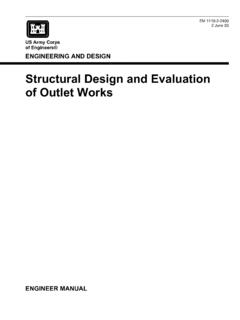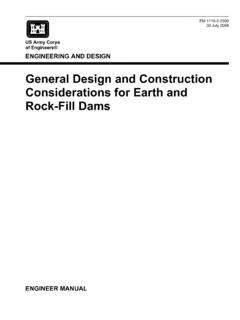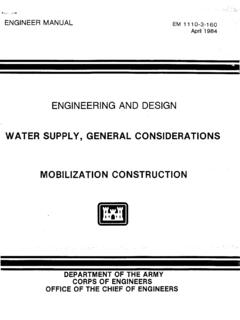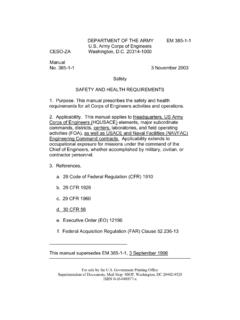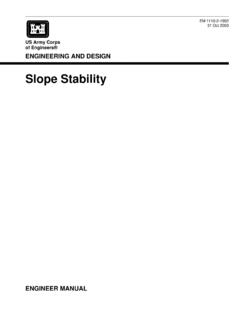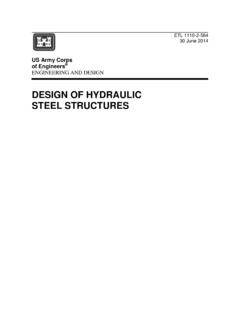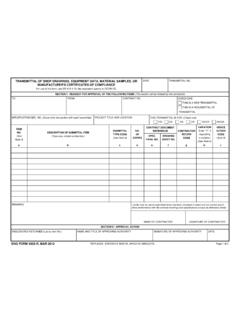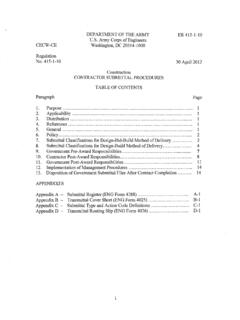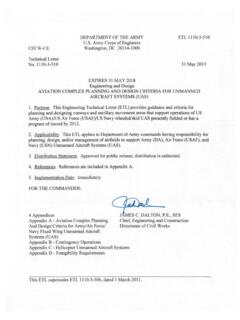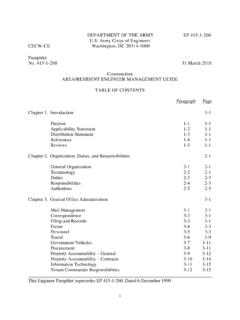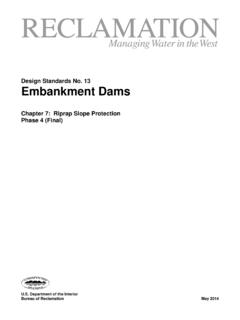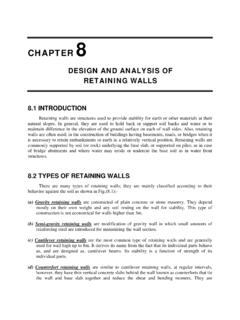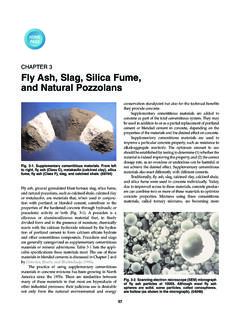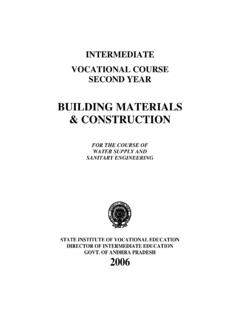Transcription of STABILITY ANALYSIS OF CONCRETE STRUCTURES
1 EM 1110-2-2100 1 December 2005 US Army Corps of Engineers ENGINEERING AND DESIGN STABILITY ANALYSIS OF CONCRETE STRUCTURES ENGINEER MANUAL No. 1110-2-2100 EM 1110-2-2100 1 Dec 05 i DEPARTMENT OF THE ARMY Army Corps of Engineers Washington, 20314-1000 Engineering and Design STABILITY ANALYSIS OF CONCRETE STRUCTURES Table of Contents Subject Paragraph Page chapter 1 General Purpose .. 1-1 1-1 Applicability .. 1-2 1-1 References .. 1-3 1-1 Distribution Statement .. 1-4 1-1 Mandatory 1-5 1-1 1-6 1-1 1-7 1-2 Coordination .. 1-8 1-3 chapter 2 Failure Modes and Wedge Sliding ANALYSIS General.
2 2-1 2-1 Limit Equilibrium ANALYSIS .. 2-2 2-1 Sliding Planes .. 2-3 2-1 Resultant Location .. 2-4 2-2 Flotation .. 2-5 2-2 Bearing .. 2-6 2-2 Geotechnical Explorations and Testing .. 2-7 2-3 Shear Strength Tests .. 2-8 2-3 Selection of Design Shear Strengths .. 2-9 2-5 Multiple Wedge Sliding ANALYSIS .. 2-10 2-6 Single Wedge Sliding ANALYSIS .. 2-11 2-8 Mandatory 2-12 2-8 chapter 3 STABILITY Requirements General .. 3-1 3-1 Load Condition Categories .. 3-2 3-1 Risk-based ANALYSIS for USACE Flood Project 3-3 3-2 Site 3-4 3-3 Critical STRUCTURES .. 3-5 3-3 Existing STRUCTURES .. 3-6 3-4 Factors of Safety for 3-7 3-4 Factors of Safety for 3-8 3-5 Limits on Resultant 3-9 3-5 Allowable Bearing Capacity .. 3-10 3-6 EM 1110-2-2100 1 Dec 05 ii Seismic 3-11 3-6 Mandatory 3-12 3-7 chapter 4 Loads and Loading Conditions General.
3 4-1 4-1 4-2 4-1 Water Loading Conditions .. 4-3 4-1 Uplift Loads .. 4-4 4-2 Maintenance Conditions .. 4-5 4-3 Surge and Wave Loads .. 4-6 4-3 Earthquake Loading 4-7 4-4 Other Loads .. 4-8 4-6 Mandatory 4-9 4-7 chapter 5 Soil Forces and Single Wedge Sliding ANALYSIS General .. 5-1 5-1 Single Wedge STABILITY ANALYSIS .. 5-2 5-1 Soil Pressures and 5-3 5-2 Soil Pressures with Water Table Within or Above Top of Backfill Wedge .. 5-4 5-6 Earthquake Inertial Forces on STRUCTURES .. 5-5 5-7 Mandatory 5-6 5-8 chapter 6 STABILITY Considerations and Analytical Methods General .. 6-1 6-1 Traditional Methods .. 6-2 6-1 Advanced Analytical 6-3 6-2 Computer Programs .. 6-4 6-4 Mandatory 6-5 6-4 chapter 7 Evaluating and Improving STABILITY of Existing STRUCTURES General.
4 7-1 7-1 Procedures .. 7-2 7-1 Improving STABILITY .. 7-3 7-2 Case Histories .. 7-4 7-3 Mandatory 7-5 7-4 chapter 8 Anchoring STRUCTURES General .. 8-1 8-1 Anchoring STRUCTURES to Rock .. 8-2 8-1 Tensioned Anchor Loads .. 8-3 8-2 Structural Anchor Design .. 8-4 8-3 Stressing, Load Testing and Acceptance .. 8-5 8-5 Monitoring Structural Anchor 8-6 8-5 Mandatory 8-7 8-5 EM 1110-2-2100 1 Dec 05 iii Appendix A References Appendix B Loading Conditions and Loading-Condition Classification Appendix C Uplift Appendix D Example Problems Appendix E Wedge Equations Appendix F Effect of Vertical Shear on the STABILITY of gravity Walls Appendix G Earthquake Forces from Backfill Appendix H Classification of STRUCTURES EM 1110-2-2100 1 Dec 05 chapter 1 General 1-1.
5 Purpose This manual establishes and standardizes STABILITY criteria for use in the design and evaluation of the many various types of CONCRETE STRUCTURES common to Corps of Engineers civil works projects. As used in this manual, the term STABILITY applies to external global STABILITY (sliding, rotation, flotation and bearing), not to internal STABILITY failures such as sliding on lift surfaces or exceedance of allowable material strengths. 1-2. Applicability This manual applies to all USACE commands having responsibilities for civil works projects. 1-3. References Required and related publications are listed in Appendix A. 1-4. Distribution Statement Approved for public release, distribution is unlimited. 1-5. Mandatory Requirements Designers performing STABILITY analyses of CONCRETE STRUCTURES are required to satisfy specific mandatory requirements. The purpose of mandatory requirements is to assure the structure meets minimum safety and performance objectives.
6 Mandatory requirements usually pertain to critical elements of the safety ANALYSIS such as loads, load combinations and factors of safety. Mandatory requirements pertaining to the guidance contained in a particular chapter are summarized at the end of that chapter . No mandatory requirements are identified in the appendices. Instead, any mandatory requirements pertaining to information contained in appendices is cited in chapters which refer to those appendices. Where other Corps guidance documents are referenced, the designer must review each document to determine which of its mandatory requirements are applicable to the STABILITY ANALYSIS . Engineers performing the independent technical review must ensure that the designers have satisfied all mandatory requirements. Waiver procedures for mandatory requirements are described in ER 1110-2-1150. This reference also indicates that deviation from non-mandatory provisions should be rare, and are subject to approval by the engineering chief in the design district.
7 1-6. Scope This manual covers requirements for static methods used in STABILITY analyses of hydraulic STRUCTURES . The types of CONCRETE STRUCTURES addressed in this manual include dams , locks, retaining walls, inland floodwalls, coastal floodwalls, spillways, outlet works, hydroelectric power plants, pumping plants, and U-channels. The STRUCTURES may be founded on rock or soil and have either flat or sloped bases. Pile-founded STRUCTURES , sheet-pile STRUCTURES , and footings for buildings are not included. When the STABILITY requirements of this manual conflict with those in other Engineering Manuals or Engineering Technical Letters, the requirements of this manual shall govern. These requirements apply to all potential failure planes at or slightly below the structure/foundation interface. They also apply to certain potential failure planes within unreinforced CONCRETE gravity STRUCTURES . This manual defines the types and combination of applied loads, including uplift forces due to hydrostatic pressures in the foundation material.
8 The manual defines the various components that enable the structure to resist movement, including anchors to the foundation. Most importantly, the manual prescribes the safety factors, which govern STABILITY requirements for the structure for various load combinations. Also, guidance is provided for evaluating and improving the STABILITY of existing STRUCTURES . 1-1 EM 1110-2-2100 1 Dec 05 1-7. Background a. General. Engineer Manuals published over the past 40 years have set STABILITY requirements for the different major civil works STRUCTURES . For sliding and bearing, the STABILITY requirements have been expressed deterministically in terms of an explicit factor of safety that sets the minimum acceptable ratio of foundation strength along the most critical failure plane to the design loads applied to the failure plane. The ANALYSIS for determination of the resultant location in prior guidance has been termed an overturning STABILITY ANALYSIS .
9 This is a misnomer since a foundation bearing, crushing of the structure toe, and/or a sliding failure will occur before the structure overturns. This manual replaces the term overturning STABILITY ANALYSIS with resultant location. b. Intent. The basic intent of the new guidance specified herein is summarized below: Provide new standard factors of safety as replacement for the somewhat variable factors of safety previously specified in other Corps guidance documents. Establish basic structural performance goals for each loading condition category. Provide tabular summaries of the structure-specific loading-condition check lists found in the other Corps guidance documents in order to properly categorize each loading condition as either usual, unusual, or extreme. Require the use of higher factors of safety for conditions where site information is not sufficient to provide a high degree of confidence with respect to the reliability of foundation strength parameters, loads information, and analytical procedures used in the STABILITY ANALYSIS .
10 Permit the use of lower factors of safety for existing STRUCTURES when there is a high degree of confidence, based on records of construction and in-service conditions, that the values of the critical parameters used in the STABILITY ANALYSIS are accurate. The process used to standardize factors of safety is based on the premise that the traditional factors of safety specified in the recent guidance for Corps CONCRETE hydraulic STRUCTURES , for the most part, provide adequate protection against STABILITY failure. The standardization process recognizes, as did previous Corps guidance, that lower factors of safety can be assigned to those loads and loading conditions designated as unusual, or extreme because the probabilities of those loads and load conditions occurring during the life of the structure are significantly less than the probabilities for usual loading conditions. The following elements were part of the safety factor standardization process: Traditional factors of safety specified in previous Corps guidance documents were used as a basis for establishing new factors of safety, which are re-formatted to be consistent with other Corps guidance that has probabilistic based requirements.
